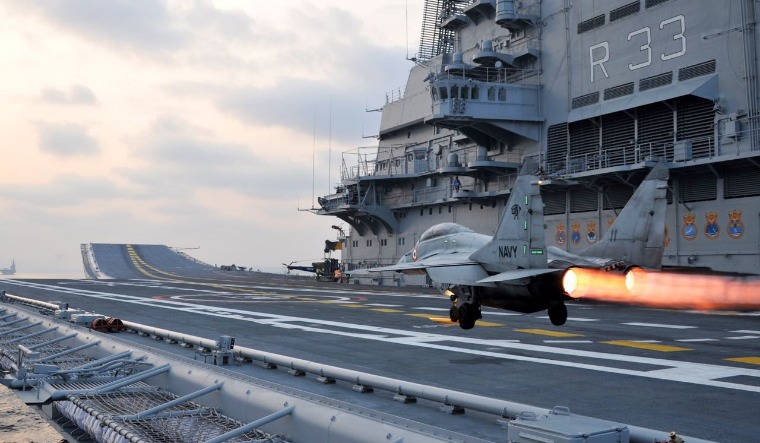Given the overall economic situation in the country and spike in tension with China in Ladakh, there has been concern in recent months that the Indian Navy's plan for a third aircraft carrier may not materialise. The Indian Navy currently has one active aircraft carrier, the INS Vikramaditya, which was purchased from Russia. An indigenous carrier, to be named the Vikrant, is due to begin sea trials by the end of this year.
The proposal for a third aircraft carrier, that would displace over 60,000 tonnes and have advanced catapults to launch heavier aircraft, was first mooted over a decade ago. The proposed vessel has been informally referred to as the 'Vishal'.
In February, Chief of Defence Staff General Bipin Rawat said the "priority" of defence planners would be submarines as the number of submarines was dwindling and the Navy would have two aircraft carriers in the next few years.
M. Matheswaran, a noted defence analyst who was a former air marshal in the Indian Air Force, has warned a third aircraft carrier is "a vital necessity for the Indian Navy, given the current tensions with China".
Matheswaran wrote an article on the Indian Navy's carrier plans that was published on Tuesday in The Interpreter, a publication of the Lowy Institute, an Australian think tank.
Matheswaran conceded the high cost of aircraft carriers was a major factor in lack of enthusiasm for such ships as other defence projects were also in need of funds. Matheswaran referred to the massive spike in cost of modernising the Vikramaditya, which saw its original price rise from $974 million to $2.35 billion. "Together with 45 MiG-29K aircraft and additional modifications, the overall price now sits somewhere between $6 billion and $7 billion," Matheswaran wrote in The Interpreter.
Matheswaran noted the cost of the Vikrant, once fully equipped with aircraft, would likely be "$10–11 billion". "The third proposed carrier, Vishal, still in conceptual stages, is expected to cost $6–8 billion and take 10–14 years to build. Including an aerial component of F-18E or Rafale aircraft at current prices, the total cost is likely to be in the order of $16–17 billion," Matheswaran wrote in The Interpreter.
However, he argued the rapid modernisation of China's aircraft carrier fleet necessitated giving priority for a third carrier for the Indian Navy.
China is believed to be building at least two large aircraft carriers in Shanghai; Beijing currently operates two aircraft carriers, both of which are larger than the Vikrant and Vikramaditya. The under-construction Chinese ships are expected to displace around 80,000 tonnes and carry electro-magnetic catapults to enable launch of heavy aircraft such as airborne early-warning aircraft.
Ski jump limitations
Matheswaran highlighted the limitations of the 'ski jump' design of the Vikrant and Vikramaditya. A ski jump is a curved ramp at the end of the flight deck. A ski jump enables an aircraft to move upward and forward, allowing take-offs with more weight and less end-speed than required for an unassisted horizontal launch. While ski-jumps allow an aircraft to take off with increased weight and give a greater safety margin, the total take-off weight of the aircraft would still be lower than that provided by using catapult-assisted launch. Moreover, the rate of consecutive aircraft launches on a ski jump carrier is lower than what is possible on a catapult-equipped ship.
Matheswaran wrote, "The navy has been operating ski-jump carriers for nearly four decades. They provide significant cost savings but come with major operational constraints. Currently, Vikramaditya operates a maximum of 24 MiG-29K fighters, along with six helicopters for anti-submarine warfare and other duties. At least 70% of Vikramaditya’s resources goes into its own air defence, leaving very little for long-range strike. Vikrant’s position will be similar. More importantly, ski-jump carriers are handicapped by their inability to launch heavier platforms, such as airborne early warning aircraft.”
Matheswaran noted "The proposed INS Vishal would be a flat-top carrier with catapult assisted take off (CATOBAR) capability, which could include an electromagnetic launch system, also knowns as EMALS. It would have a sizeable air component of 70–80 aircraft, including helicopters and early warning aircraft, giving it a significant strike capability and reach."
He emphasised that the high cost of building a third aircraft carrier would be spread across 10 to 14 years, which would make it "more manageable".
US concerns
In November 2016, The Wall Street Journal reported that US officials who inspected the Vikrant, which is being constructed in Cochin, were sceptical about the ship's utility.
The Wall Street Journal then reported the US officials "discovered the carrier wouldn’t be operational for up to a decade and other shortcomings: no small missile system to defend itself, a limited ability to launch sorties and no defined strategy for how to use the ship in combat".





